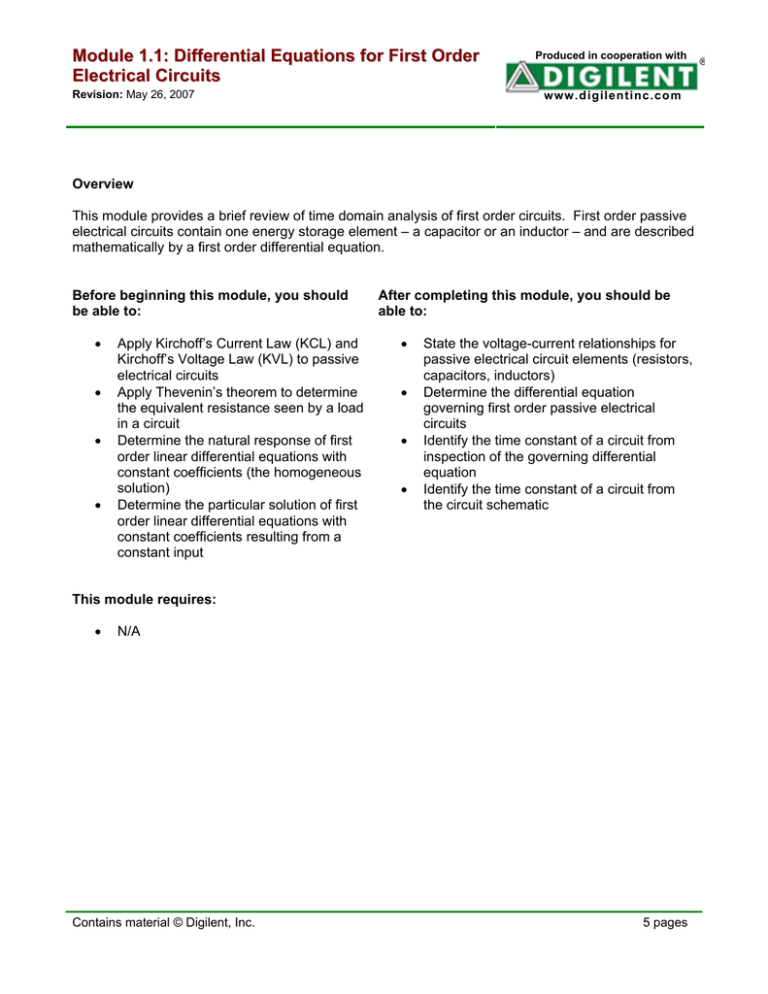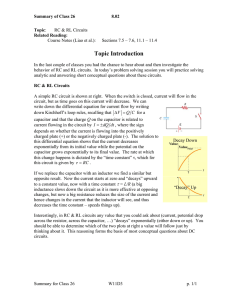Module 1.1: Differential Equations for First Order Electric Circuits
advertisement

Module 1.1: Differential Equations for First Order Electrical Circuits Revision: May 26, 2007 Produced in cooperation with www.digilentinc.com Overview This module provides a brief review of time domain analysis of first order circuits. First order passive electrical circuits contain one energy storage element – a capacitor or an inductor – and are described mathematically by a first order differential equation. Before beginning this module, you should be able to: • • • • Apply Kirchoff’s Current Law (KCL) and Kirchoff’s Voltage Law (KVL) to passive electrical circuits Apply Thevenin’s theorem to determine the equivalent resistance seen by a load in a circuit Determine the natural response of first order linear differential equations with constant coefficients (the homogeneous solution) Determine the particular solution of first order linear differential equations with constant coefficients resulting from a constant input After completing this module, you should be able to: • • • • State the voltage-current relationships for passive electrical circuit elements (resistors, capacitors, inductors) Determine the differential equation governing first order passive electrical circuits Identify the time constant of a circuit from inspection of the governing differential equation Identify the time constant of a circuit from the circuit schematic This module requires: • N/A Contains material © Digilent, Inc. 5 pages ® Page 2 of 5 Module 1.1: Differential Equations for First Order Electrical Circuits A block diagram for a general system is shown in Figure 1 below. The input u(t) is a known function of time. It could be, for example, a voltage or current applied to the system by an ideal source. The output y(t) is simply the measured response of some parameter in the system; for example, a voltage or current response in some system component. u(t) y(t) System Figure 1. Overall system block diagram. Ex 1 1 The equation governing the relationship between u(t) and y(t) is called the input-output relation. In general, the input-output relation is a differential equation. For an electrical system, this differential equation is determined by application of Kirchoff’s Current Law, Kirchoff’s Voltage Law, and the voltage-current relations for the individual circuit components (e.g. Ohm’s Law, for resistors). For first order systems, the input-output relation is a first order differential equation. In general, the order of the differential equation governing a system is equivalent to the number of equivalent energy storage elements in the system; first order circuits contain a single equivalent energy storage element (inductor or capacitor). Circuit element governing equations: Governing equations for inductors, capacitors, and resistors are shown in Figure 2. The governing equations for energy storage elements are differential equations. The governing equation for a resistor is not a differential relation; purely resistive circuits will therefore be governed by algebraic relations rather than differential equations. i(t) i(t) + V(t) - R Resistor: v(t ) = Ri (t ) + V(t) - Capacitor: dv(t ) i (t ) = C dt i(t) C + V(t) - L Inductor: v(t ) = L di (t ) dt Figure 2. Governing equations for resistor, capacitor, inductor. First order differential equations: The general form of a first order differential equation is: a1 dy (t ) + a 0 y (t ) = u (t ) dt where a1 and a0 are constants. This equation is generally re-written in the form: (1) Page 3 of 5 Module 1.1: Differential Equations for First Order Electrical Circuits dy ( y ) 1 1 + y (t ) = u (t ) dt a1 τ (2) where τ is the time constant of the system. The time constant provides a measure of how quickly the system responds to a change in the input value. Step Response of first order differential equation: ⎧ 0, t < 0 , the solution to the input-output ⎩ A, t > 0 For the special case when u(t) is a step function, u (t ) = ⎨ equation (1) is: y(t ) = K1 + K 2 e −t / τ (3) where K1 and K2 are constants which are determined by application of the boundary conditions (initial condition, final condition) of the system. If the initial condition y(t=0+) = 0, the solution becomes: y (t ) = A (1 − e −t / τ ) , a0 (4) since the steady-state response (the response as t → ∞ ) of equation (1) for this input is y (t → ∞) = A . a0 RC and RL circuits: Ex 1 2 First order circuits consisting of a single equivalent resistance and a single equivalent capacitance are called RC circuits. To characterize these circuits, the time constant and the steady state response must be known in order to completely characterize the circuit’s step response. For RC circuits, the time constant τ = Req C eq , where Ceq is the equivalent capacitance and Req is the equivalent (Thevenin) resistance seen by the capacitor. For a step input, the steady state response of an RC circuit can be determined by replacing the capacitor with an open circuit and determining the resulting output of the circuit. First order circuits consisting of a single equivalent resistance and a single equivalent inductance are called RL circuits. Again, the step response of these circuits can be determined from the time Ex 1 3 Ex 1 4 constant and the steady state response. For RL circuits, the time constant τ = Leq Req , where Leq is the equivalent inductance and Req is the equivalent (Thevenin) resistance seen by the inductor. For a step input, the steady state response of an RL circuit can be determined by replacing the inductor with a short circuit and determining the resulting output of the circuit. Page 4 of 5 Module 1.1: Differential Equations for First Order Electrical Circuits For either RL or RC circuits, equation (4) is completely specified by the steady state response (which provides A ) and the time constant (which provides τ). a0 Example: RC circuit Consider the circuit shown in Figure 3. The input to the system is the voltage across the resistorcapacitor combination. The system output is the voltage across the capacitor. R + Vin(t) - + C Vout(t) - Figure 3. Series Resistor-Capacitor (RC) circuit. Kirchoff’s Voltage Law, applied around the entire loop results in the following input-output equation for the circuit: Vin (t ) = RC dVout (t ) + Vout (t ) dt (5) Comparison of equations (2) and (5) indicate that for this circuit τ = RC . This is as expected from the previous discussion of RC circuits, since with only one resistor and one capacitor, R=Req and C=Ceq. The steady state response of this system to a step input in Vin(t) can be determined by replacing the capacitor with an open circuit and determining the resulting Vout. Since open-circuiting the capacitor results in zero current through the circuit, this results in Vout (t → ∞) = Vin (t → ∞) . Module 1.1: Differential Equations for First Order Electrical Circuits Page 5 of 5 Notes: • Circuits with a single energy storage element (an inductor or capacitor) are first order systems and are mathematically modeled by first order differential equations. • The time-domain responses of first order systems are typically characterized by their time constant, τ. o The natural response of a first order system (the response to some initial condition, with no applied input) is completely characterized by the time constant. In this case, the time constant is equal to the amount of time required for the system’s output to decay to approximately 36% of its initial value. o The step response of a first order system (the response to a step input, with zero initial conditions) is characterized by the time constant and the steady-state response. In this case, the time constant is the time required for the system to reach approximately 63% of its final value. • The time constant of an RC circuit is τ = Req C eq , where Ceq is the equivalent capacitance and Req is the equivalent (Thevenin) resistance seen by the capacitor. • The time constant of an RL circuit is τ = Leq Req , where Leq is the equivalent inductance and Req is the equivalent (Thevenin) resistance seen by the inductor.


